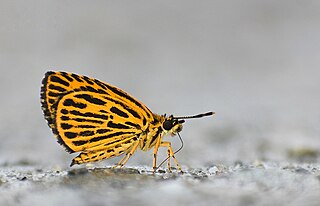
Oreolyce vardhana, the dusky hedge blue, is a small butterfly found in Sri Lanka that belongs to the lycaenids or blues family.

Nacaduba pavana, the small four-line blue or Singapore four-line blue, is a species of lycaenid butterfly found in Southeast Asia.

Rectiostoma xanthobasis is a species of moth in the family Depressariidae. It was described by Philipp Christoph Zeller in 1876. It is found along the Atlantic Coastal Plain from south-eastern Massachusetts south to central Florida and eastern Texas, and north in the Mississippi Valley to Missouri and Illinois.

Euphaedra luperca, the Nigerian blue forester, is a butterfly in the family Nymphalidae. It is found in southern Nigeria and western Cameroon.

Euphaedra medon, the widespread forester, is a butterfly in the family Nymphalidae. It is found in Senegal, the Gambia, Guinea-Bissau, Guinea, Sierra Leone, Liberia, Ivory Coast, Ghana, Togo, Benin, Nigeria, Cameroon, Equatorial Guinea, Gabon, the Republic of Congo, Angola, the Democratic Republic of the Congo, Sudan, Ethiopia, Uganda, Kenya, Tanzania and Zambia.
Inga crucifera is a moth in the family Oecophoridae. It was described by August Busck in 1914. It is found from Panama to Peru.

Aristotelia elegantella is a moth of the family Gelechiidae. It was described by Vactor Tousey Chambers in 1874. It is found in North America, where it has been recorded from Arizona, California, Colorado, Illinois, Indiana, Iowa, Kansas, Kentucky, Louisiana, Mississippi, New Mexico, Ohio, Oklahoma, Ontario, Texas and Utah.
Chrysoesthia lingulacella, the silver-banded moth, is a moth of the family Gelechiidae. It was described by James Brackenridge Clemens in 1860. It is found in North America, where it has been recorded from Alberta, Arizona, California, Illinois, Indiana, Iowa, Maine, New Hampshire, Quebec and Texas.
Rectiostoma argyrobasis is a moth in the family Depressariidae. It was described by W. Donald Duckworth in 1971. It is found in the humid low highlands of northern Venezuela and south-eastern Brazil.
Rectiostoma chrysabasis is a moth in the family Depressariidae. It was described by W. Donald Duckworth in 1971. It is found in Santa Catarina, Brazil.
Rectiostoma cirrhobasis is a moth in the family Depressariidae. It was described by W. Donald Duckworth in 1971. It is found in the humid low highlands of Guatemala and El Salvador.
Rectiostoma cnecobasis is a moth in the family Depressariidae. It was described by W. Donald Duckworth in 1971. It is found in the high highlands of Peru and Bolivia.
Rectiostoma flinti is a moth in the family Depressariidae. It was described by W. Donald Duckworth in 1971. It is found in Mexico.
Rectiostoma ochrobasis is a moth in the family Depressariidae. It was described by W. Donald Duckworth in 1971. It is found in the humid low highlands of south-eastern Peru and Bolivia.
Rectiostoma silvibasis is a moth in the family Depressariidae. It was described by W. Donald Duckworth in 1971. It is found in Venezuela.
Rectiostoma thiobasis is a moth in the family Depressariidae. It was described by W. Donald Duckworth in 1971. It is found in Brazil.
Rectiostoma xuthobasis is a moth in the family Depressariidae. It was described by W. Donald Duckworth in 1971. It is found in Colombia.
Rectiostoma callidora is a moth in the family Depressariidae. It was described by Edward Meyrick in 1909. It is found in the humid low highlands of south-eastern Peru and north-western Bolivia.
Rectiostoma haemitheia is a moth in the family Depressariidae. It was described by Cajetan Felder, Rudolf Felder and Alois Friedrich Rogenhofer in 1875. It is found in the humid low highlands of western Venezuela, central Colombia and Costa Rica. It has also been recorded from Panama and Brazil (Amazonas).

Ochus subvittatus, the tiger hopper, is the only species in the monotypic moth genus Ochus of the family Hesperiidae. The genus was erected by Lionel de Nicéville in 1894. The species was first described by Frederic Moore in 1878. It is found in the Khasi Hills and Naga Hills of India, Myanmar, Thailand, Laos, Vietnam and Yunnan.






